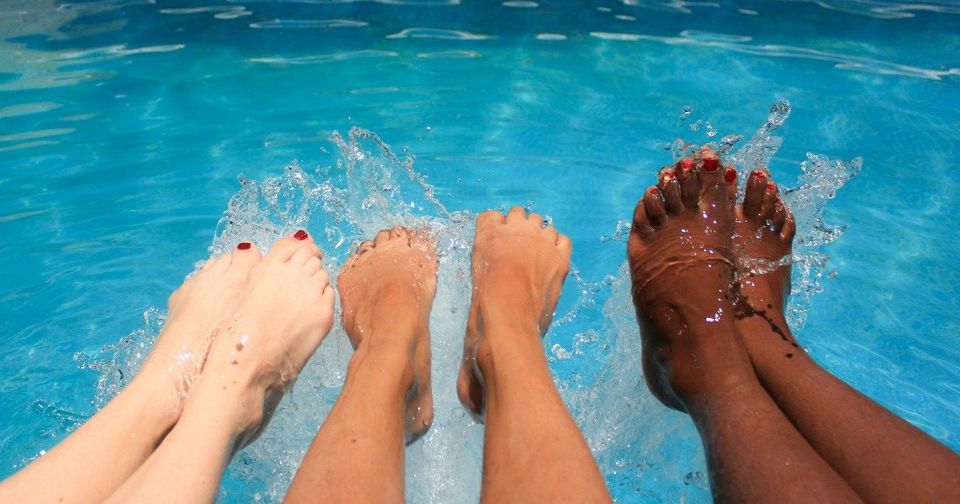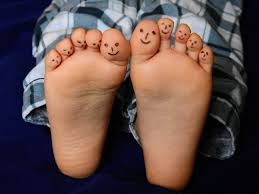Your feet are amazing
“The human foot is a masterpiece of engineering and a work of art”
….. Leonardo da Vinci
Since taking our very first steps, we rely on our feet every day for so
much. But how much do you know about them?
Surprising facts about feet
- Each foot is made up of 100 moveable parts, including 26 bones and 20 muscles.
- The bones in both feet make up around a quarter of all the bones in your body.
- With every mile you walk, you shift approximately one hundred tonnes (the weight of a blue whale) just by moving your own body weight forward.
- The average person will walk around 150,000 miles in their lifetime
– that’s more than four times around the Earth.
Look after your feet! Our feet are incredible.
And it’s easy to take them for granted. We only have one pair of feet, so we owe them more of our attention!
Here we share some very simple steps for keeping our feet healthy and in peak condition.
And we highlight five common foot problems that you can manage yourself at home – and advise when it’s best to seek help from a podiatrist.
Top tips to help prevent foot problems
Follow our simple steps to help to keep your feet in tip top shape and reduce your risk of developing any problems.
- Wash your feet every day Use warm, soapy water and take care to dry them well, especially between your toes – this will help to prevent fungal infections, such as Athlete’s foot.
- Do regular calf stretches Get into a routine of doing these every day to keep your feet supple.
- Pay attention to your socks Wear well-fitting socks and change them every day to avoid sweaty feet.
- Trim your toenails Use proper nail clippers – and cut them straight across, not too short and not down at the corners, as this can lead to ingrowing toenails.
- Keep them moisturised If the skin on your feet is dry, put moisturiser on your feet before you go to bed, avoiding between the toes (this can lead to fungal infections).
- Wear the right footwear It’s important to make sure your shoes are the right size for your feet. Buy footwear in the afternoon when your feet are at their largest. Get your feet measured if you are unsure of your size.
- Rotate your shoes Try not to wear the same shoes two days in a row, to reduce your chances of developing a fungal infection.
- Vary your heel height Keep high heels for special occasions, as regular use can damage your feet.
- Check your feet regularly
Giving your feet the once over every week will help you to spot any possible
problems quickly
Five common foot conditions
If you do spot any problems with your feet, it’s easy to ignore them and hope they go away. The good news is that there are some easy things you can do to help prevent any issues becoming more serious.
Heel pain
Can be debilitating, affecting walking and posture. The most common cause is plantar fasciitis, when the ligament that runs under the heel becomes swollen.
Who gets it?
Can affect anyone at any age, but is most common in those in their 40s or in athletes.
What can I do myself to help prevent or manage it?
- Wear well-fitting shoes, with good heel cushioning and arch support.
- Avoid walking or exercising on hard ground.
- Rest regularly and try not to walk or run too fast.
- Wear a raised heel (no more than 6-10 mm higher than normal)
A bony lump on the side of your foot where the big toe excessively angles towards the second toe.
Who gets it?
Although anyone can get a bunion, they tend to be more common in women.
What can I do myself to help prevent or manage it?
- Give your toes room to move by opting for wider shoes.
- If you wear high-heeled shoes, do so in moderation.
- If you want to wear a heel every day, keep heel heights to 4cm or less – and vary your heel heights from day to day.
- Choose shoes with laces, or a strap or buckle over the instep.
- If the bunion becomes inflamed or troublesome, see a podiatrist.
Hard, thickened areas of skin, caused in response to rubbing, friction or pressure on the skin.
Who gets it?
They can affect anyone, but may be caused by badly fitting shoes or a biomechanical irregularity in your feet.
What can I do myself to help prevent or manage it?
- Gently rub the area with a pumice stone or foot file when you are in the bath.
- Moisturising cream may help soften the thickened skin.
Develops when the side of a toenail pierces through the flesh of your toe, making it red, inflamed and painful. It most commonly affects the big toe.
Who gets it?
Anyone, but particularly people who cut their nails incorrectly leaving small spikes of nail behind. Sporty people are more prone because they are likely to get moist, sweaty feet – this can make the skin around the toenails softer and easier for a nail to pierce.
What can I do myself to help prevent or manage it?
- Cut your nails properly – straight across, making sure not to trim them too low at the edge or down the side. Leave the corner of the nail so it’s visible above the skin. Doing it after a bath or shower is helpful, when your nails are softer.
- Avoid moist feet by rotating your shoes and choosing well-fitting socks and shoes made from natural materials.
- At home get your feet out and let the air get to your toes as much as possible!
Podiatry is the field of medicine that specialises in assessing, diagnosing and treating conditions of the foot and lower limb. A podiatrist can also give you advice about foot care, gait analysis and on the best footwear for you and your family.
When do I need to see a podiatrist?
In many cases, following our self-care tips will help the problem improve. If it doesn’t, it’s best to seek professional help.
You should visit a podiatrist if:
Your feet hurt – they will assess your condition and advise you on the best treatment.
Your symptoms are getting worse – a problem isn’t improving naturally, or within three weeks of self-care.
You want to prevent foot problems – a regular foot check can help keep your feet healthy.
How do I get an appointment with a podiatrist?
There are different ways to see a podiatrist, and may depend on where you live:
Go through your GP
They may be able to refer you for an NHS podiatry appointment. Or in some areas, you may be able to self-refer.
Visit your local independent practice podiatrist
It’s important to find a professional who is registered with the Health and Care Professions Council (HCPC), which is the UK-wide regulatory body. Use the tool on our website to find a podiatrist near you: https://www.scpod.org/find-a-podiatrist
Betafeet Podiatry, Hemel Hempstead and Tring 01442 822990 www.betafeetpodiatry.co.uk
More Posts






